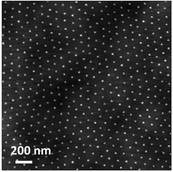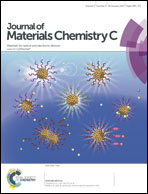Homopolymers as nanocarriers for the loading of block copolymer micelles with metal salts: a facile way to large-scale ordered arrays of transition-metal nanoparticles
Abstract
A new and facile approach is presented for generating quasi-regular patterns of transition metal-based nanoparticles on flat substrates exploiting polystyrene-block-poly2vinyl pyridine (PS-b-P2VP) micelles as intermediate templates. Direct loading of such micellar nanoreactors by polar transition metal salts in solution usually results in nanoparticle ensembles exhibiting only short range order accompanied by broad distributions of particle size and inter-particle distance. Here, we demonstrate that the use of P2VP homopolymers of appropriate length as molecular carriers to transport precursor salts into the micellar cores can significantly increase the degree of lateral order within the final nanoparticle arrays combined with a decrease in spreading in particle size. Thus, a significantly extended range of materials is now available which can be exploited to study fundamental properties at the transition from clusters to solids by means of well-organized, well-separated, size-selected metal and metal oxide nanostructures.


 Please wait while we load your content...
Please wait while we load your content...